A Better Circle.so Alternative to Create An Online Community: Circle vs Heights Platform
11 minute readCircle is an online community platform designed for creators who want to build an online space for their audience to interact and connect.
One of Circle.so alternatives is Heights Platform.
Heights Platform is the all-in-one, AI-powered course creation software and community platform that offers all the tools creators need to build and scale an online knowledge business.
Circle.so recently introduced courses into their features. So let's see how Circle compares to Heights Platform in their community, courses and other features.
Community Building: Circle.so vs Heights Platform
First, let's start with Circle.so's main feature: online communities.
Both Circle and Heights let you build highly customizable, engaging online communities for your members.
While communities are at the very core of Circle.so services, Heights Platform offers many more features for creators. That said, Heights Platform's online communities are a very complete tool and offer all the features you need as a creator.
The main difference is that Heights Platform offers a built-in community as one of the features of their online course platform, while Circle.so is mainly just a community platform.
With their recent addition of courses, Circle.so customers can now create basic learning programs, but they still lack the complexity and feature-richness of a more mature online course platform like Heights Platform.
Back to the communities, let's see what you can achieve with both online community platforms.
Structuring a Community
Heights Platform's communities can be structured into "channel groups" and "channels," while Circle.so calls them "spaces." Essentially, both community platforms work in a similar way when it comes to structuring the content inside your online community.
Both platforms allow you to set up a community space for your members and students to interact with each other, ask questions, discuss specific topics and share with the community.
On Heights Platform, creators and community admins have the power to organize the community area by moving channels and groups around on the sidebar.

Communities follow a certain order that affects how content is displayed. There's a button labeled "Unread" on the community sidebar in Heights Platform. When you click it, you'll see the latest posts, with the ones you follow and the recently updated ones shown at the top.
So, if you're keeping track of unread posts, the ones you follow will be above unread posts that you haven't followed, even if the unfollowed post is newer.
This is handy for students who don't want email notifications.
In the Heights community, you can group conversations into different areas called channels. Channel groups work like folders to keep your channels organized. While you need at least one channel, using channel groups is optional. They're helpful when you have many channels and want to group them by topic.

By default, a channel and its posts are visible to all students. If you don't want students to post in a new channel, tick the "Locked" box. This lets students see the content but not create discussion posts. For instance, you might do this for an announcement or rules channel.
You can change the order of channels by dragging them on the sidebar. Members can chat and start discussions in channels unless a channel is "locked," which means only admins can post there.
You can style posts the way you like, and add pictures and multimedia. You can also "Lock" a post (so members can't comment), or "Pin" it (it stays at the top with unread and followed posts).
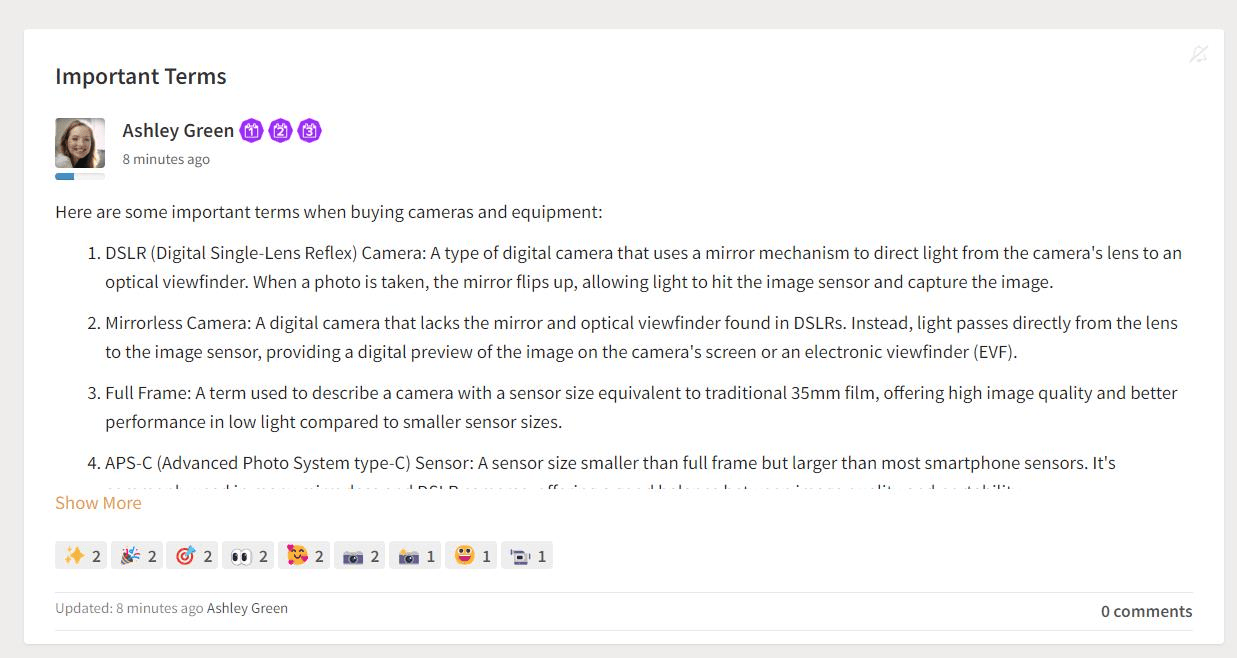 Once you've published a post, you can go back and edit it. You can also move a post from one channel to another.
Once you've published a post, you can go back and edit it. You can also move a post from one channel to another.
Other community members can react to posts and post comments under them, as well as mention other community members. All of these features are also available in Circle.so.
Takeaway: Both Heights Platform and Circle.so allow you to customize a community as you want. You can create spaces or channels, group them together and lock them. The way members post in the community is similar on both platforms.
If you want to learn more about creating your online community, check out these articles:
- Why You Should Build an Online Community of Engaged Customers and How to Do it
- How to Choose the Right Online Community Platform For Your Knowledge Business
- 7 Steps to Revive Your Online Community and Increase Engagement
Hiding a Community Channel
In Heights Platform, a community channel can be either part of your whole community or made private by adding it to a Bundle (potentially selling the channel separately).
This way, only paying members with access to the Bundle, or people who have been granted the bundle, will be able to access the channel.
A similar outcome can also be achieved in Circle, by creating private spaces.
Takeaway: Both Circle.so and Heights Platform let you hide a community space and sell it to a certain group of people.
Payment Options
Both community platforms give you the option to charge a fee for community access (one-time fee, a subscription fee, or multiple payments).
Heights Platform also lets you charge a pay-what-you-want fee to your members, where they can choose how much to pay to enroll in your membership community, or you can use it as a donation button.
Takeaway: In both community platforms you can set different payment methods for members to access a community. Heights Platform also allows for pay-what-you-want pricing.
Member Limit
Heights Platform doesn't apply any limits on how many members can join your online community. Instead, there are limits on contacts and active students. Let's see what they mean.
In Heights Platform's Basic Plan, creators can have up to 5,000 contacts and 300 active students.
Active students are people who logged into your program in the last calendar month, therefore "active". You might have over 5,000 students that have continuous access to your program, but at any given month, if only 300 login, then you have 300 Active Students.
Additionally, Heights Platform does not set hard limits on the amount of contacts and active members you can have. For example, if you have 305 active students, you won't be forced to immediately upgrade for that month. Likewise, if you have a sudden burst of 320 active students but only for a single month, you won't be forced to upgrade if your plan only allows 300.
On the other hand, Circle.so Basic Plan only allows for 100 members.
Takeaway: Heights Platform has higher limits in terms of active students and contacts, while Circle has stricter limits.
Transaction Fees
Another important distinction between Circle.so and its alternative Heights Platform is the transaction fees.
Circle.so charges a 4% transaction fee on their Basic Plan, meaning that for every sale you make, 4% of your earnings will go to Circle.
All of Circles's pricing plans have transaction fees, even when you pay $399/month in their Enterprise Plan, you still have a 0,5% fee.
Heights Platform doesn't charge any transaction fees, so everything you earn is 100% yours to keep.
Takeaway: Heights Platform doesn't charge any transaction fees, Circle's transaction fees are up to 4% per sale.
Gamification
Gamification is an essential part of online learning and community engagement, and it can make all the difference in the success of your online community or course.
Heights Platform has many built-in gamification features.
You can give out points to learners when they complete a new lesson in your course, automatically generating badges after certain milestones and assigning rewards by measuring members' progress.
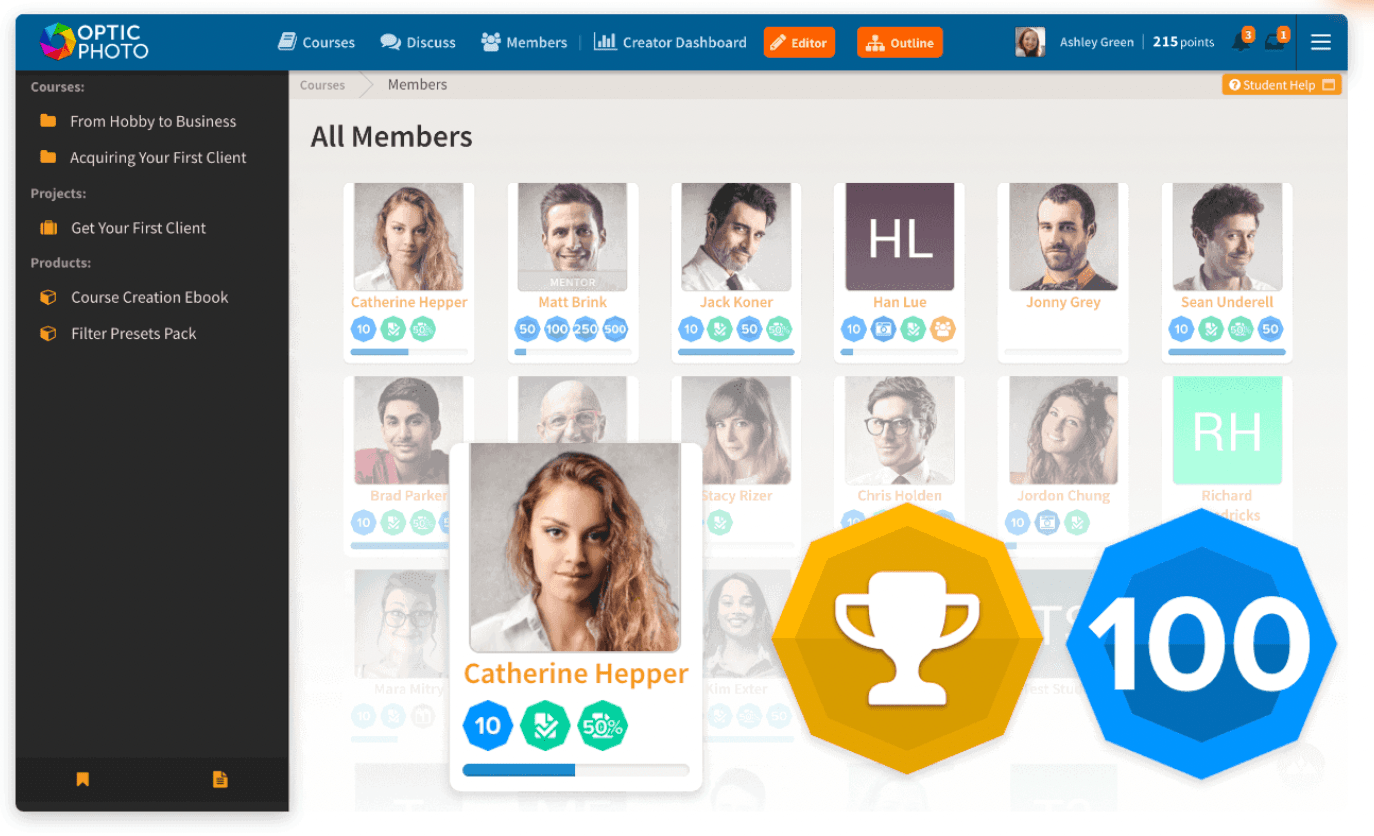
Gamification tools can make your online business not only valuable but fun and engaging!
Circle.so doesn't have built-in gamification features like the points and badges Heights Platform offers.
When Circle.so lacks in gamification tools, you can be sure that Heights Platform has them all.
Badges are showcased in the community area when members post a new message or comment, making it an interactive experience and incentivizing other members to become more active.
Takeaway: Circle.so does not have any gamification features, while Heights Platform has many (points, badges, rewards, assignments, projects, and certificates of completion).
Pricing
Circle has four main pricing plans.
Circle's entry-level plan is the Basic plan, which costs $49/month.
Circle's most popular plan is the Professional plan, which costs $99/month or $89/month if paid yearly.
If you want more features and customizable, Circle.so has a Business plan for $219/month and an Enterprise plan for $399/month.
The last Circle's pricing plan is Custom pricing, not available publicly. However, it is expected to be around $30K/year.
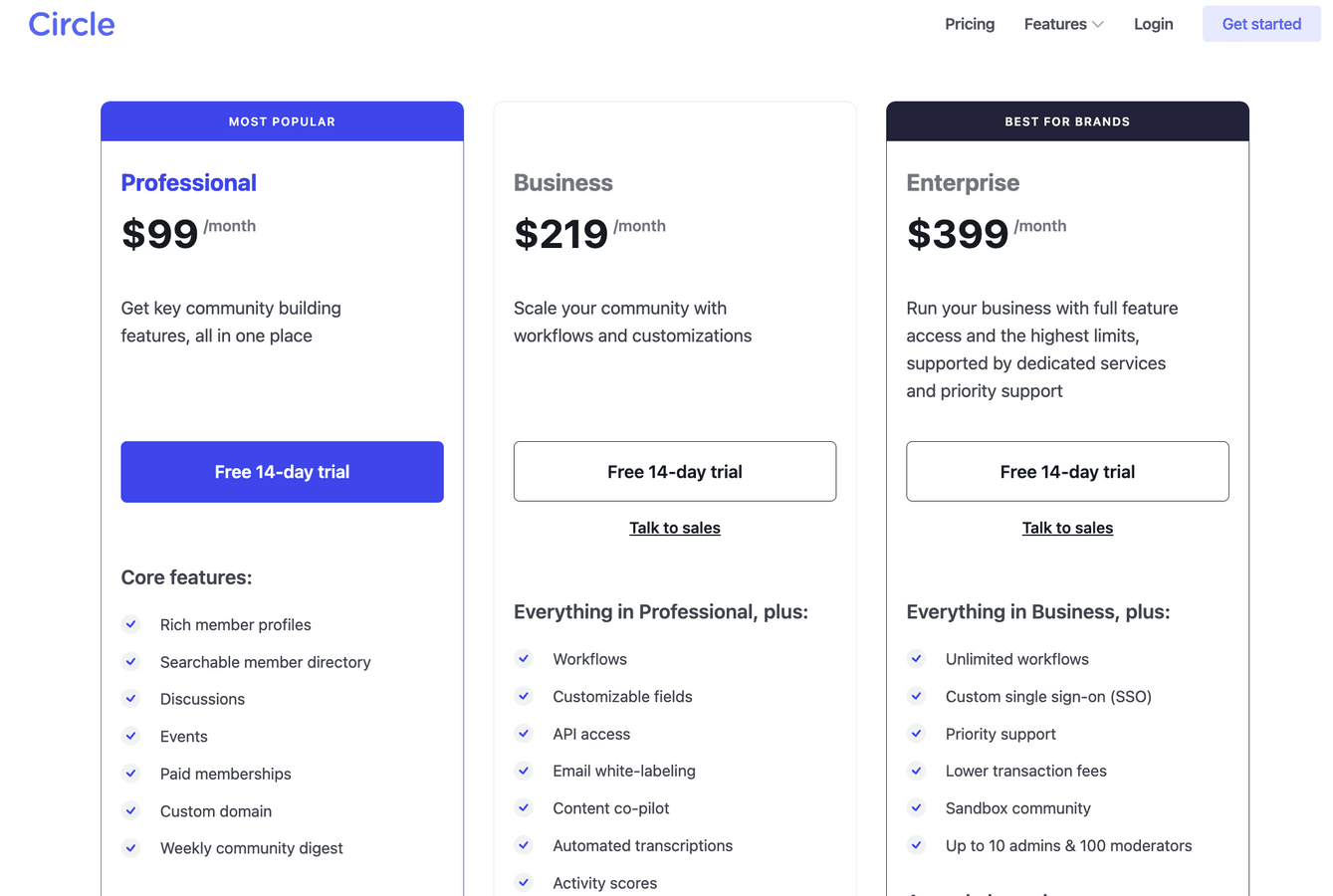
Heights Platform's Basic plan is also $49/month if paid monthly or $39/month if paid yearly.
Heights Platform's Pro plan is $119/month if paid monthly or $99/month if paid yearly.
Heights Platform's Academy plan is $399/month if paid annually.
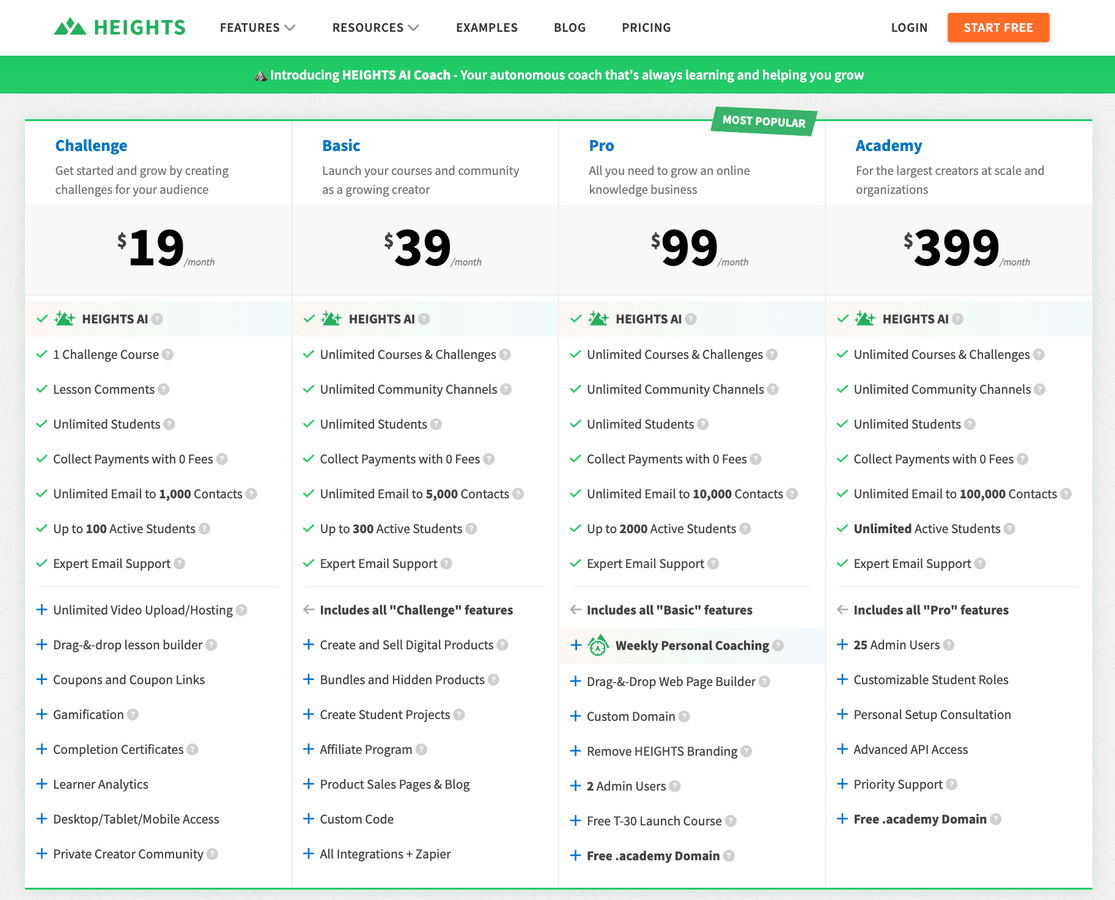
As you can see Heights Platform's and Circle's pricing is relatively similar.
However, with Heights Platform, you get all the features you need to build a scalable business, even with the Basic Plan. Circle.so on the other hand, only offers community features and a basic course creation tool, not comparable with the capabilities of Heights Platform.
Plus, let's not forget about the transaction fees.
As an example, if you earned $ 5,000 in one month from Circle on their Pro plan, you'd pay $100 of fees plus another $99 for the subscription - double of what you would pay using Heights.
Building a thriving community is an important part of any business, but - for most creators - it is not the main core of their business. Most creators also sell engaging online courses, membership sites, challenges, digital products and coaching programs. Plus, they need software to build their website, send email campaigns and organize their marketing strategy.
With Heights Platform, you pay one subscription to be able to do all that - and build a complete business using one app only. With Circle, you can build communities and basic courses, but that is it.
If you want to create a sustainable business that grows, you'd have to integrate Circle.so with another online course platform, and pay an extra subscription on top of it.
Takeaway: Circle and Heights Platform have similar base pricing, but Circle charges transaction fees on top of its subscription. Plus, for a lower price Heights Platform is more feature-rich.
Course Creation
Circle.so has recently added a basic course builder to its community platform.
However, not all of their pricing plans allow for course creation. Only the Professional plan at $99/month lets you create courses.

Heights Platform is at its core a course creation platform, so naturally the ability to create courses is available in all plans.
Plus, on Heights Platform you can choose between different types of learning programs you can create.
Here is an overview of all the different digital products you can create and sell on Heights Platform:
- Self-paced online courses: traditional online courses comprised of lessons and modules.
- Membership sites: sell access to a learning platform in exchange for a monthly or annual fee.
- Online challenges: time-bound courses with a set start and end date, where lessons are released on set calendar dates and expire.
- Digital products or downloads: digital products that can be downloaded or accessed by your students, such as PDFs, worksheets, events, live streams, coaching sessions etc...
- Online communities: as we already discussed in this article, spaces where members can interact and communicate.
- Bundles of products: groups of selected products listed above, that can be sold as a whole and even hidden.
On top of this, creators using Heights Platform have the flexibility to manage these products as they like.
Both in Heights and Circle, you can apply a drip feed to your online courses.
However, only Heights Platform allows you to schedule multiple launch dates for your courses or memberships, pre-sell your programs, lock course lessons so students can access them only after completing the previous ones, create assignments and projects to help students learn, design and assign certificates of completion, and more! (All of these are not possible in Circle).

Another important distinction is that Circle does not offer built-in hosting for your course videos.
Heights Platform offers a robust video hosting and encoding service with multiple benefits over third-party video providers. If you prefer to upload your video files directly to Heights instead of using a third-party video service, you can upload a video file from your computer, and we will transcode it into multiple resolutions and file types so that it can be played back quickly across every kind of device.
Takeaway: Circle.so only has very basic course creation features, while Heights Platform lets you build unlimited courses (Basic plan and up) with secure video hosting and choose from a variety of learning products to sell. Plus, you can structure them as you like.
Marketing Features
Heights Platform and Circle have features like upsells, coupons, and discounts and both tools support multiple currencies.
Both Circle and Heights have built-in email marketing tools. However, Heights Platform allows you to send announcements to all your members and email campaigns.
Other than these basic common marketing features, Heights Platform has all you need to build and promote a thriving online community business.
First, on Heights Platform you can build an entire website for your business, complete with unlimited sales pages, with an easier-than-drag-and-drop page builder (included free in the Pro Plan). Also on the Basic Plan, you can automatically build landing pages for your product.
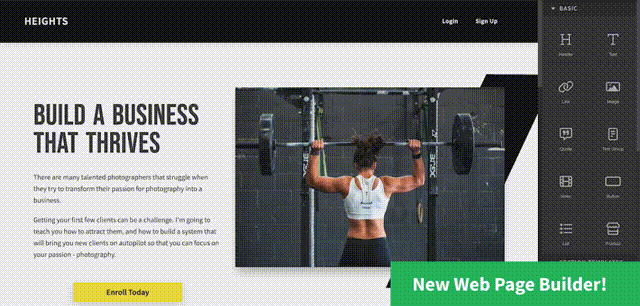
The Web Page Builder in Heights Platform has multiple ready-made templates you can choose from, and then edit by dragging and dropping building blocks, or even start from scratch.
Heights Platform also allow you to build your own affiliate program and let your members and students refer your business to others - and create your own blog!
Takeaway: Circle.so does not have marketing features other than upsells and discounts, and basic emails. Heights Platform has a web page builder where you can create an entire website with unlimited pages, your own affiliate marketing program, a built-in blog, email marketing, announcements and email campaigns, and more.
AI Features
Last but definitely not least, the AI features in Heights Platform will let you rethink all the other course platforms you have considered until now.
The Heights AI is an artificial intelligence tool for course creators, powered partly by Chat-GPT APIs, designed to assist creators in building and growing their online course business.
This AI course creator tool can help online course creators generate an online course in seconds, offer recommendations and guidance, generate marketing elements and coach creators on how to build a thriving online business or use Heights Platform.
Unlike other general AI tools that simply generate or summarize text, the Heights AI has been specifically trained on everything the Heights Platform team knows about online course creation and promotion.
Here are the main ways to use the AI in Heights Platform:
- Generate an online course in minutes and get feedback on your idea: By giving a simple online course title to the AI, it generates the actual course on your Heights account, complete with a powerful online course title, lesson outline, course description, and even a cover image! All automatically built for you inside Heights Platform!
- The AI Becomes your personal business coach: Grow your online business to the next level with personalized coaching and autonomous assistance from the AI Coach: your personal AI mentor, available 24/7 to assist in growing of your business. After checking your progress and chatting with you about your goals, the AI Coach comes up with an action plan and sends you weekly tasks tailored to your needs.
- Chat with the AI and ask questions about course creation, marketing and how to use Heights: The Heights AI chat can answer a wide variety of questions related to building and promoting an online course and provide coaching and support on how to use Heights Platform.
- The AI can edit your products: The Heights AI becomes your own personal assistant. Simply provide a text command to the AI and explain it what you would like to edit. After confirming, the AI immediately applies your changes to the product. For example, you could ask it to "Change my online course price to $300," "Publish my Yoga course," "Enable the landing page of my online photography challenge", or even more commands altogether.
- Improve your website's SEO: The AI checks your webpages (created in Heights Platform) for SEO, and offers insights on how to improve your page's content based on SEO principles. This way, your website can rank higher on search engines like Google and get easily discovered by your ideal clients.
Takeaway: Circle.so does not have any AI features. Heights Platform has plenty, including an automated course creator, your own AI coach helping you grow your business, AI editor as your personal assistant, AI chat to learn about course creation and how to use the platform, and an AI SEO checker.
Heights Platform: The Best Alternative to Circle.so
So, which community platform is best for you?
In this article, we discussed one of Circle.so alternatives, Heights Platform, and how they compare in terms of features.
Let's see an overview of the features that make each platform unique.
Features you can only find in Heights Platform:
- AI features
- More robust and complex course creation tools
- Gamification (badges, points, assignments, projects)
- Sell digital products
- Create membership sites
- Run online challenges
- A complete web page builder
- Create unlimited courses (basic plan and up)
- Robust and secure video hosting
- Affiliate Program
- Built-in blog
- More developed email marketing
- Course creation settings (locking content, scheduling launches, pre-selling)
- Certificates of completion
- No transaction fees
- Higher limits on members
- Detailed analytics on community members and students
Features you can only find in Circle:
- Community dashboard (coming soon also in Heights Platform!)
- Native live streaming feature (coming soon also in Heights Platform!)
- Embed widget to embed community spaces in other platforms
- Community templates
- Workflows
- Mobile app
- Group chat
Features you can find in both platforms:
- Community building and options to structure the community
- Community moderation
- Create private spaces
- Multiple payment options
- Discounts, upsells and coupon codes
- Custom branding and style
- Integrate multiple handy tools
What do you think of this community platform as one of Circle.so alternatives?
Heights Platform is one of the best alternatives to Circle.so out there, and an all-in-one platform that doesn't stop at community building but lets you create and grow your entire online knowledge business with courses, memberships, coaching and much more.
Create Your Community Today


